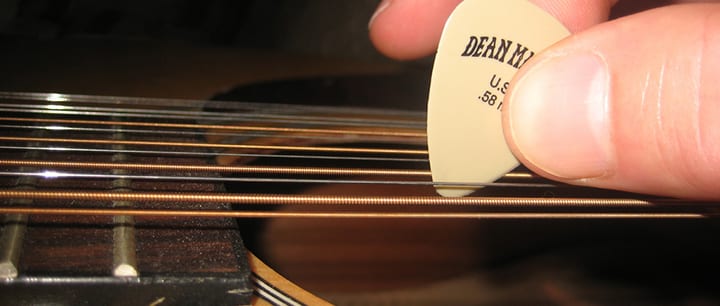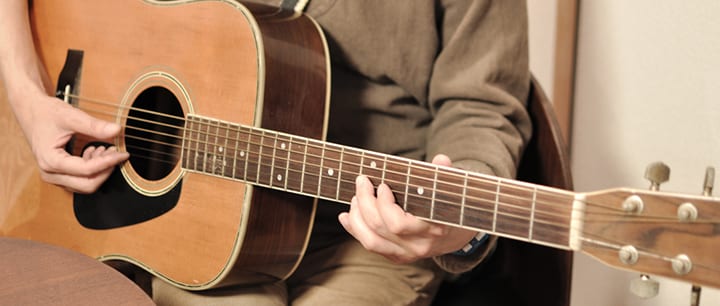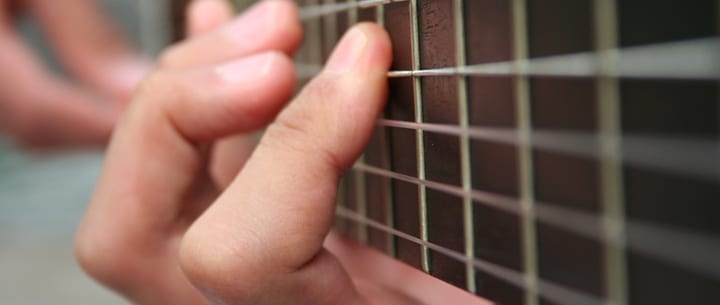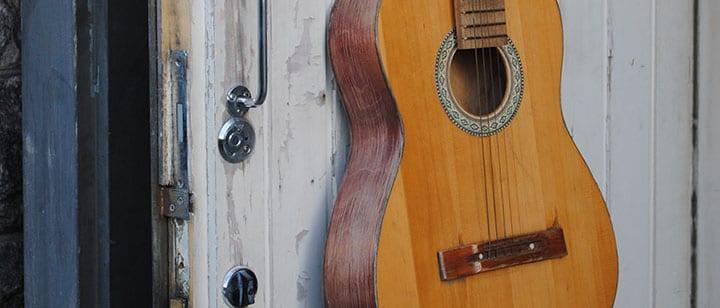As with any new skill, learning how to play the guitar comes with challenges. Here, Perth Amboy, NJ teacher Jeff S. shares his guitar playing tips to help you stay motivated…
I’ve been teaching guitar to students of all ages and skill levels for many years and have gotten quite adept at spotting and remedying the challenges faced by beginners. So I’ve decided to address them in this article to offer students and their parents some insight on how to get beyond the problems so they can truly enjoy the guitar experience.
Below are brief descriptions of each problem and the guitar playing tips to correct them:
Problem #1 – The guitar pick keeps slipping out of my hand

Solution:
While the thickness of a guitar pick is an individual preference, I don’t recommend a thin pick. It’s too flimsy and offers little stability and control. So I suggest a medium gauge pick (.60 mm to .88 mm) and sometimes a medium-heavy pick (.80 mm to 1 mm). I also strongly suggest a “grip pick,” as the regular flat plastic picks can be slippery and fall to the floor. There are many varieties of grip picks, but I personally prefer the Jim Dunlop Nylon Standard pick (I use the 1 mm, but some might find it too rigid).
Besides the type of pick, it’s important to hold the pick with the thumb and index finger (tucking in the other three fingers to form a loose partial fist) and in doing so create a striking surface of no more than a quarter of an inch (at the tip end of the pick).
Problem #2 – The notes I’m trying to fret sound muffled or not very clear

Solution:
There are three important guitar playing tips that go along with this. First, you want to be sure your nails aren’t too long (i.e. beyond the fingertips) and you’re making fingerboard contact using the fleshy part of the fingertip — not with the nail or under-nail area or the back of the finger. Second, the point of contact should be with the fleshiest part of the fingertip. Third, the left hand needs to be arced upright as much as possible (without causing discomfort) so that it’s reasonably perpendicular to the neck. And finally, the left hand fingers shouldn’t press down on the fret, but rather slightly to the left of the fret.
Problem #3- My fingers hurt and it’s tough to keep playing

Solution:
The old-school solution would simply be to say “No pain, no gain,” or “Your finger discomfort will go away soon.” And honestly, that’s probably pretty good advice. But here are some more constructive solutions:
- Make sure the guitar has light or extra light gauge strings on it, as the thickness of the strings directly impacts how sore the fingers get.
If none of these guitar playing tips offer sufficient help, consider trying a pain-reducing ointment with benzocaine on your fingertips. (Be sure to consider the allergic potential and also be sure that your child doesn’t put his or her fingers in their mouth after applying such a product.)
Problem #4- I can’t stretch my fingers of my left hand to reach the 3rd or 4th frets, or I’m having trouble applying enough pressure to fret a note

Solution:
Every guitarist will need to access the 3rd and 4th frets with their ring finger and pinky, respectively. And it’s not just to play the notes on those frets, but to gain overall hand control and fingerboard accessibility.
I often assign the chromatic scale to students as a finger stretch and warm-up exercise. Using the left hand index, middle, ring, and pinky fingers, respectively, play the notes on the first four frets (delegating index to 1st fret, middle to 2nd fret, ring to 3rd fret, pinky to 4th fret) to play a total of 24 notes (four per string).
Another great way to increase reach is to pick up a small rubber ball (handball size) and squeeze it several times before you practice guitar. You can also spread your fingers apart on the ball, much the way a baseball pitcher would spread them to throw a changeup. This particular pitch calls for separation between the index, middle, and ring fingers, and that’s the perfect stretch to develop more finger reach for guitar. You can see the grip here.
Conclusion
Whether you’re the one learning guitar, or if you’re a parent trying to support your child, the most important thing to remember is that there’ll always be learning curves and growing pains to overcome and a need for patience and perseverance to get beyond them. Once a new guitar student gets used to fretting notes and how much hand pressure is needed to fret notes, and their skin toughens up a bit on their fingertips, things will fall into place. Be encouraging and they’ll get past these early challenges.
 Jeff S. teaches guitar, ukulele, speaking voice, songwriting, and more in Perth Amboy, NJ, as well as online. Jeff has created and taught songwriting and music business classes at colleges, universities, and music schools throughout the country for many years. Learn more about Jeff here!
Jeff S. teaches guitar, ukulele, speaking voice, songwriting, and more in Perth Amboy, NJ, as well as online. Jeff has created and taught songwriting and music business classes at colleges, universities, and music schools throughout the country for many years. Learn more about Jeff here!
Photo by Juhana Leinonen, yoppy, Made Underground, keith ellwood
Suzy S.

